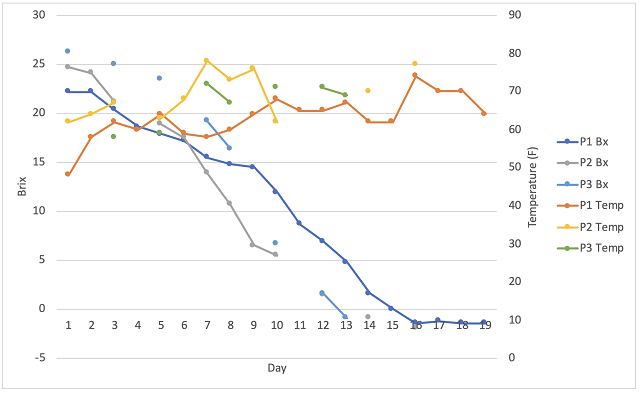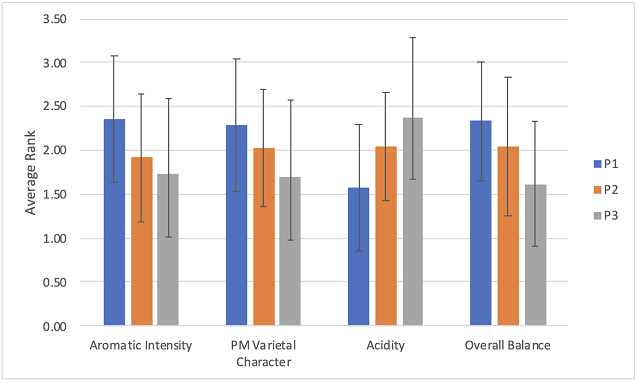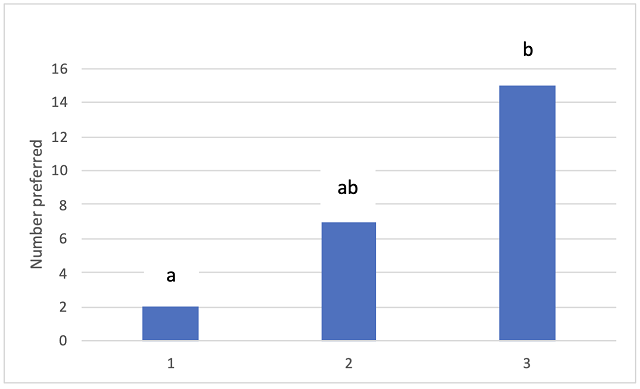Harvesting Petit Manseng at Three Levels of Sugar and Acid: Tarara Winery
Jordan Harris
Tarara Winery
Summary
Petit Manseng is a grape variety that shows great promise in Virginia vineyards, but has challenges in the winery, where it is difficult to balance acidity, alcohol and strong tropical flavors to achieve a harmonious wine. In this experiment, Petit Manseng was harvested at three target Brix (22.5, 25, and 26.3) and made into wine using identical winemaking techniques. Resulting wines showed predictable increases in alcohol and decreases in acidity measures with grape maturity. None of the wines had values for sugar:acid balance that fell within published values for quality white wine. In blind sensory analysis, wine from the third harvest was ranked as having more aromatic intensity, Petit Manseng varietal character, and overall balance. Wine from the first harvest had the highest perceived acidity. Participants preferred wine from the third harvest.
Introduction
Petit Manseng is a grape variety that shows great promise in Virginia vineyards, but has challenges in the winery, where it is difficult to balance acidity, alcohol and strong tropical flavors to achieve a harmonious wine. Several winemaking strategies have been explored to find a balance of acid and alcohol in Petit Manseng when fermented dry. Some winemakers have experimented with earlier harvest dates to reduce alcohol level and tame some of the aggressive aromatics Petit Manseng can present, however this must be balanced with acidity that may be very high with an early harvest. Skin contact prior to fermentation releases potassium that can precipitate tartaric acid and lead to lower acid wines, however this must be balanced with the introduction of phenolics that can be texturally apparent and can lead to early browning. Some have attempted malolactic fermentation, however high alcohol and high acidity are a challenging environment for O. oeni and can lead to high levels of volatile acidity. Aging the wine on yeast lees for an extended period of time (18 months) can lead to release of polysaccharides from yeast hulls that add roundness to the wine but can come with the added risk of VA accumulation and browning during long aging.
The purpose of this investigation was to explore the balance of alcohol and acid that occurs when Petit Manseng is picked at different levels of ripeness. The hope is that there may be a sweet spot for balancing these elements in a dry wine. Additionally, changes in the flavor profile of Petit Manseng were assessed to determine the progression of characteristics from mineral to tropical with different levels of maturity in this variety. In this experiment, Petit Manseng was harvested at three target Brix: 23, 25, and 27.
Methods
A single block of Petit Manseng was harvested three times, at target Brix of 23, 25, and 27 based on fruit sampling data. The block was picked every third row each time. All winemaking operations were the same for each lot. The grapes were destemmed prior to pressing with the addition of Cinn Free, and cuvée was separated from from taille. Only the cuvée was used for this experiment. The juice was settled 24 hours before being racked to stainless steel barrels for fermentation. Fermentation was held at an ambient 55°F to keep the fermentation temperature between 52°F and 65°. Juice was inoculated with 30 g/hL EC1118 rehydrated in 25 g/hL GoFerm. A higher rate of yeast was used to encourage fermentation of the higher Brix grapes. Nutrients (20 g/hL Fermaid K and 40 g/hL DAP) were added between 1/3 and ½ brix depletion. At the completion of alcoholic fermentation, 66 mg/L S02 was added. The wine was aged on its fermentation lees with stirring every two weeks. A target free SO2 was maintained at 25 mg/L with weekly checks until stable for three testing cycles, after which SO2 was monitored monthly.
Sensory analysis was completed by a panel of 26 wine producers. Wines were presented blind in randomly numbered glasses. There were three tasting groups with each group encountering the wines in a different order. Tasters were asked to rank the wines based on overall aromatic intensity, Petit Manseng varietal character, acidity, and overall balance. A group discussion prior to tasting identified characteristics that contribute to Petit Manseng varietal character. Participants were also asked to indicate which of the three wines they preferred and given open ended questions to describe the wines. Results for the ranking tests were analyzed using Friedman’s test with multiple pairwise comparisons using Nemenyi’s procedure. Differences in preference were determined with a Chi square.
Results
Petit Manseng was harvested at 10 day intervals (Table 1). There was an increase of 2.4°Bx, little change in pH, and a decrease of 1.5 g/L titratable acidity between the first and second picks. The second interval yielded a smaller increase in sugar (1.5°Bx) and much larger shift in pH (from 2.93 to 3.32) and TA (3.9 g/L).
Juice from Pick 1 had a longer lag phase than Picks 2 and 3 (Figure 1). This may be due to the challenging acidity of the juice from the first pick, or due to higher ambient yeast inoculant in the winery as harvest progressed. Picks 1 and 2 both completed fermentation with relatively low levels of volatile acidity while Pick 3 stopped with 5.8 g/L residual sugar and higher volatile acidity (Table 2).
Several metrics of sugar:acid balance have been defined as measures of maturity for quality wine production, as reviewed by Plessis (1984)1 and Bisson (2001)2. Both authors caution that ranges for quality wine are variable across regions and are not always good indicators of varietal character, however, these measures do provide a value for balance that can be compared across vintages and sites. None of the three harvest dates produced grapes with Brix:acid relationships that are within the range of quality wine (Table 4). Values from the first two picks are too low, likely due to very low pH/very high TA. The last pick yielded values that are too high. Here, the window of opportunity seems to have been missed. This is not uncommon; Plessis (1984)1 reviews several examples where potential quality declined significantly within a week, and some never achieved true balance. It may be that some sites or vintages are not well suited to dry style Petit Manseng.
Ranking of the wines for each of the characteristics was either significantly or nearly significantly different. When interpreting ranking, it is important to note that a 1 corresponds to the “most” (think “1st place”) while 3 corresponds to “least”. Wine made from the last pick was ranked as having the most overall aromatic intensity (Q=5.36, p=0.07), Petit Manseng varietal character (Q=4.87, p=0.09) and overall balance (Q=7.03, p-0.03) while wine from the first pick was ranked as having the most acidity (Q=8.71, p=0.01)(Figure 2), with open ended comments revealing several participants found the acidity in this wine too be off-putting. Wine from the third pick was preferred by more respondents than wine from the first pick (X2 = 5.8, p=0.06)(Figure 3)
Table 1: Juice chemistry for three picks of Petit Manseng (in-house data)

Table 2: Finished wine chemistry for three picks of Petit Manseng (ICV Labs Jan 2020)

Table 3: Measures of maturity for quality wine production for three picks of Petit Manseng

Figure 1: Fermentation kinetics for three picks of Petit Manseng

Figure 2: Average ranking for aromatic intensity, Petit Manseng varietal character, acidity and overall balance for wines from three picks of Petit Manseng. In this ranking, 1=most, 3=least

Figure 3: Wine made from the third pick was significantly preferred over wine made from the first pick.

References
(1) Plessis, C. S. D. Optimum Maturity and Quality Parameters in Grapes: A Review. South African Journal of Enology and Viticulture 1984, 5 (1), 34–42.
(2) Bisson, L. F. Geographic Origin and Diversity of Wine Strains of Saccharomyces. American Journal of Enology and Viticulture 2012, 63 (2), 165–176.
